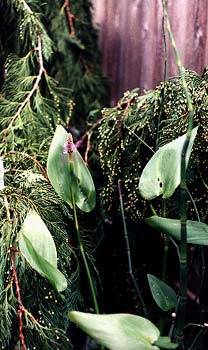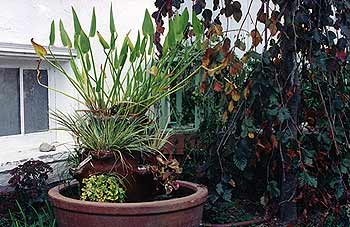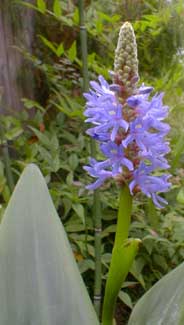
Blue Pickerel Rush,
a native wildflower
Pickerel Rush (Pontederia cordata) from the water hyacinth family is a native bog plant that requires very damp conditions with water at the level of its crown. It grows in shallows & wants only the roots submerged.
I'd previously planted it in an aquatic forest bowl (shown below), with water pumping through the pot so that the pickerel's hefty rootstock functioned as a natural filter for the water. It flourished without troubles, but I was never totally satisfied with the way I'd arranged the bowl itself, so a few seasons later I took the planted bowl apart & turned it into a fountaining garden pool for minnows & dwarf cattails.
The pickerel rush's rhizomitous tuber had grown so large that I could not get it out of the pot whole, but it divided easily. I replanted the smaller parts of the tuber in a somewhat dryer but well-watered location to see if it would adapt. In those locations it hasn't died, but it hasn't grown swiftly either, so it defintely does best in water-margin conditions.
The main large tuber I planted in a pot to sit in another aquatic forest bowl, until a racoon tramped through the bog area ripping things up, causing considerable damage to the pickerel that was on the verge of bloom until ruined by our masked raider. At that point I replanted it close to an alaska weeping cedar, in a sunken five gallon paint bucket so that the soil could be kept perpetually wet for it. The racoon still visits from time to time but has never again shown interest in wrecking the pickerel.
It was a mite slow to bounce back from the shock of division followed by the bad luck of a good racoon-tramping, & being twice transplanted. Still, it was in good form by Autumn when its delayed purply-blue flowers finally reappeared. The photo at the top of the page shows the leaves against the Alaska Cedar in October 2002. The third photo (below) is a close up of one of its flowers in October 2003.
 It needs at least four hours of sun daily to do its best. Its lance-shaped or arrowheaded foliage grows to three or four feet high from the dense thick tuber. Each stem terminates in one of the large leaves, & it is beautiful primarily for the bold upright arrowheads. When not stressed by circumstances, it blooms steadily summer & autumn, but even in imperfect circumstances blooms in autumn. It sends up thick spongy flower-stems that terminate in a two-inch clusters of tiny blue flowers.
It needs at least four hours of sun daily to do its best. Its lance-shaped or arrowheaded foliage grows to three or four feet high from the dense thick tuber. Each stem terminates in one of the large leaves, & it is beautiful primarily for the bold upright arrowheads. When not stressed by circumstances, it blooms steadily summer & autumn, but even in imperfect circumstances blooms in autumn. It sends up thick spongy flower-stems that terminate in a two-inch clusters of tiny blue flowers.There is considerable variation in the species over its extensive range throughout the eastern half of North America. Some gardened specimens have these flower tops quite large & showy, but in our garden the flowering spike tips have always been smallish though still quite attractive. This may in part be due to the hermaphriditic flowers needing to crosspollinate with other specimens, though that is just a guess. Over much of its range it is pollinated by the bee species Dufourea novae-angliae which specializes in attending to pickerels & no other flowers.
 In winter the leaves begin dying back & can be cut off at the base if they get too homely. If not trimmed back it looks a fright as winter progresses, the spongy leaf-stems & flower-stems rotting. Certainly by spring it must have the previous year's remaining foliage discarded to make room for new growth.
In winter the leaves begin dying back & can be cut off at the base if they get too homely. If not trimmed back it looks a fright as winter progresses, the spongy leaf-stems & flower-stems rotting. Certainly by spring it must have the previous year's remaining foliage discarded to make room for new growth.Pickerel rush is not generally invasive & in some areas of its range it is a threatened species. Elsewhere it is common enough it is called Pickerelweed. It is called "Pickerel" because it is so commonly found in the vicinity of pickerel frogs & occasionally pickerel fish, & because the arrowheaded stems resemble picks or spikes.
It's other names include Dogtongues alluding to the leaves, Blue Flag (coopting a name usually reserved for water irises), & Wampee, from an Algonquin word meaning "Dawn" but homonimous for whites with "swampy." Wampee is elsetimes the name of a somewhat similar bog plant, the Arrowleaf or Water Arum, vis, Peltandra virginica, & truncated to "Wamp" it is an Indian name for North American elder trees & their berries. Coincidentally wampi or wampee, as corrupted from the Chinese citrus fruit name wang-pei (huang-p'i), similarly corrupted in the Philippines as huampit or uampi, is the name of Clausena lansium (aka Cookia punctata or Clausena wampi) or of its fruit.
Though it is not widely realized that pickerel rush is edible, the seeds can in fact be eaten like small nuts, boiled with rice, or ground up & added to flour. Tender young leafstalks are edible either raw or cooked. Any part of the plant can be cooked in stews.